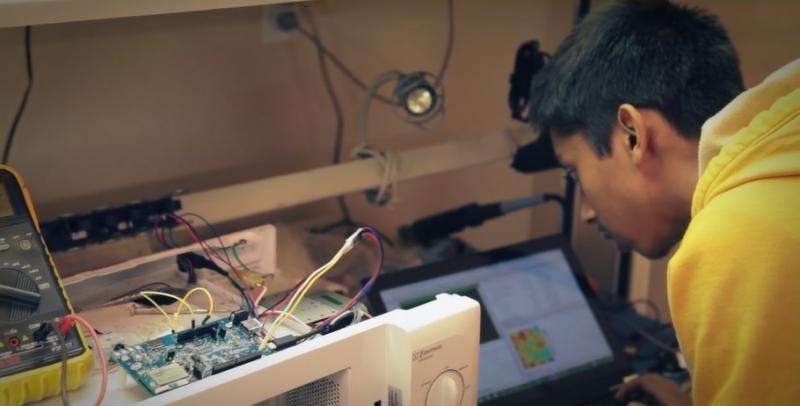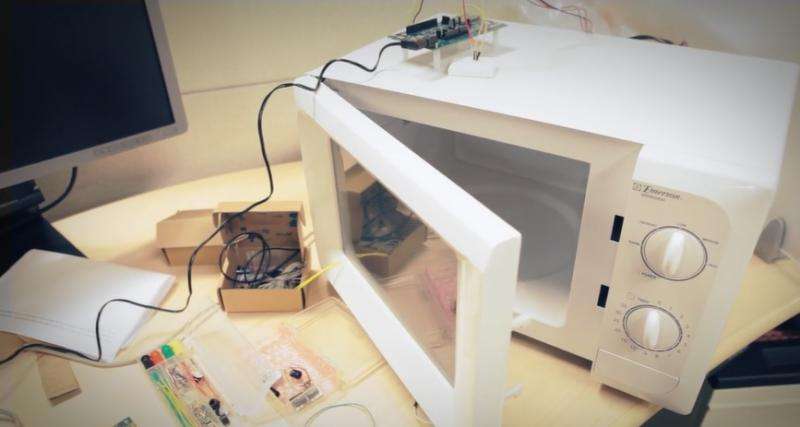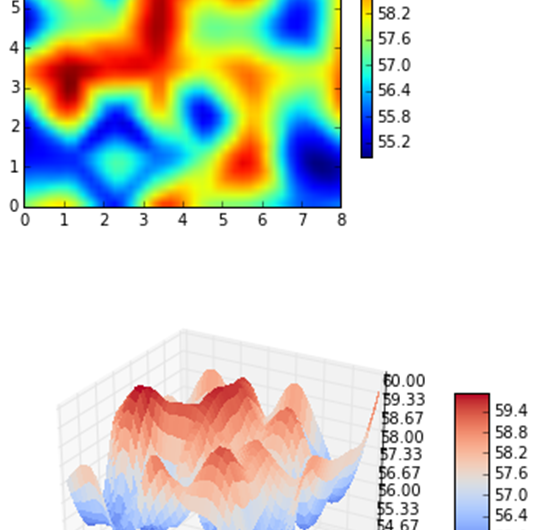15-year-old boy builds smart microwave that spares the salad

A desire to help his father make a perfect cup of hot tea inspired this Oregon teenage tinkerer to use his advanced math and computer programming skills to transform a conventional microwave oven into an automated smart kitchen appliance.
Most evenings, Shahir Rahman watched as his father struggled to heat up his tea in the microwave, a ritual that often resulted in a mess. The tea would inevitably bubble and spill over, and his dad would burn his fingers handling the hot teacup.
The now 15-year-old Shahir knew there had to be a better way and was inspired to solve these warming woes. So he set out to build a smarter microwave, one that would consistently heat any solid and liquid (tea included) to ideal temperatures.
Shahir reasoned the smart microwave had to be intelligent enough to know what it was cooking and cheap enough to be replicated. This balance would make it appealing to others who struggled to warm their favorite foods and beverages.
"If you look at current-day heating applications, there's different kinds—for comfort, for warming the house, for cooking—but the cooking part hasn't become smart," said Shahir.
"This was something that I wanted to change. I wanted to improve cooking, prevent burns and create better food," he explained.
Shahir is the son of two veteran engineers at Intel, Asifur Rahman and Rawshan Jahan. The straight-A high school student has been coming up with innovative, problem-solving science fair ideas for years and is charting a path to attend a STEM-focused college in California so he can follow in his parents' career footsteps.
Father and son already share a few interests. They spend hours together tinkering on electronics and building drones inside their cluttered at-home workshop.
It was there that Asifur flew and crashed one of their Lego drones into a table, sparking a small fire. When the in-house fire alarm failed to sound, Shahir thought about heat and how it was measured. That led him to his current tech project.
"My goal is to eventually create a device that could warm up food without any user input," he said.
Shahir also knew that if the smart microwave required "5 bajilion sensors to calculate everything," then it would be too expensive to build and more difficult to replicate. That would be a recipe for failure.
Using the scientific method as his guide, Shahir began his quest to research, hypothesize, experiment and, most importantly, map out the steps and materials required to build a better microwave. The project required advanced mathematics and computer algorithms, things he would have to learn.
Nothing held Shahir back.
The Experiment Begins
First, the father and son duo studied how heat works in a conventional microwave. To do this, they cannibalized a $15 model they purchased at the local Goodwill.
"We researched it a little bit and found out that the microwave radio energy is very targeted," Asifur Rahman said. He explained that the turntable helps to heat food evenly because some areas inside the microwave get hotter than others.
The two scientists sprinkled shredded cheese on a plate and microwaved it without the turntable to reveal the microwave's high, low and "no" heat points.
"We discovered that if we used that property of the targeted heat, then we could build a microwave that skips the salad while heating the mashed potatoes correctly," explained Asifur.
Shahir fitted an infrared sensor on the top panel inside the microwave to record the exact cooking temperatures. This data allowed him to create heat maps showing heat inside the microwave rises and distributes over time.

Using the map data, Shahir needed to understand how the heat would impact the solids and liquids he put in the microwave.
Different foods, he discovered, have different heat maps and temperature profiles. To achieve targeted pixel-based heating (TPBH), the sensor would need to know how to react to a wide variety of temperature profiles.
Using TPBH, the microwave automatically heats each plate (or not) according to the food items' specific characteristics instead of based on user input. Shahir wanted his smart microwave to identify foods in order to calculate the ideal target temperature and time required to heat it.
Recording the target temperature of various foods became a family affair. Armed with a handheld temperature gun, Shahir and his parents measured everything from home-cooked meals to restaurant-prepared dishes.
"I had to find out what the optimum temperature was for different kinds of foods," said Shahir. For example, he determined that the average person prefers coffee to be 74 degrees Celsius.
He also noticed an inverse relationship between viscosity and optimum serving temperature. While it seems obvious that people prefer soup, a low-viscosity food, hotter than something with a higher viscosity like rice, it helped Shahir calculate how to warm different items.
"By looking at the viscosity, I was able to determine mathematically what temperature the food needed to reach so that it was lip-ready and the person could eat right away," Shahir said.
He used this information to build temperature profiles for everything from his favorite noodle soup to frozen salmon filets. Then there was the advanced math.
The Engineering
Using an Excel spreadsheet, Shahir worked on a mathematical algorithm that would take the food temperature data, calculate the viscosity, compile, rotate and smooth the data before calculating the target temperature.
He quickly found Excel wasn't up to the task of advanced computing.
"My real journey began when I started learning Python," Shahir said of his adventure into the complex world of programming languages. In addition to learning Python, the young Rahman needed to learn to compute complex math concepts like derivatives and gradients to ensure the appliance was smart enough to identify and heat anything he put inside.
He had a break in the project, however, when he stumbled on an online Python library filled with different preprogrammed mathematical modules.
"From there, I was able to modify them and create an algorithm of my own that I used for my food property determination," Shahir explained.
Eventually he got the Python program to do exactly what the Excel version did: simulate viscosity graphs and calculate viscosity using a bilinear algorithm. This program would help the smart microwave identify food and calculate how hot and how long it would need to be warmed in order to reach its lip-ready temperature.
As the algorithms and hardware designs took shape, Asifur reached out to his coworkers at Intel about supporting his son's project. Soon Shahir had support from engineers in Intel's New Devices Group and Internet of Things Group.

"Shahir is a brilliant young man," said James Russell, director, platform engineering for the Internet of Things Group. "He had been doing so much theory, math and analysis on paper, but lacked the practical applications and mentors. That's where we came in."
The Intel teams gave the young Rahman advanced tools and taught him how to frame and approach each problem in order to complete his vision for a smart microwave.
"He is like a kid in a candy store," said Russell, describing the 15 year old.
"The reason Shahir is successful is that he doesn't know what he doesn't know, so he just tries everything," Russell said. "That's so refreshing. It's incredible to see a young man accomplish so much with a positive attitude and passion."
Building the Beast
With engineering support and the algorithm and program in place, Shahir bought an infrared Panasonic thermopile array sensor—a low-cost, low-resolution sensor that could detect the food's temperature without touching it.
Shahir used the sensor's data to run his algorithm, which calculated viscosity, but not other variables like the amount of food, density and other characteristics.
"What's really difficult about this is that if you look at standard algebra equations, to solve for two variables—x and y—you need to have two equations, but what I was dealing with was much more complicated," Shahir explained. "I only had one variable, temperature, and I had to solve for multiple variables."

His solution? Create virtual food profiles inside a microchip.
"Using the Intel Edison, I can take data directly from the sensor and use the module's wi-fi capabilities as a cloud computing device to calculate the variables required to run the microwave."
While the programming is complete, the microwave's radiation interferes with some of the electronic circuits. Shahir is currently working to fix the sensor so that it will work underneath the radiation.
This hardware-related task is the last barrier to the final product, but he's confident it will be done within the next three months.

He's even exploring how to alter the technology to solve related problems, like detecting fires before they begin.
As with all his experiments, Shahir ultimately wants to make a positive impact.

"Most of my projects are about ordinary ideas for ordinary people, but they have a great impact in the solution," he said.
"It all starts with an idea."
Provided by Intel


















